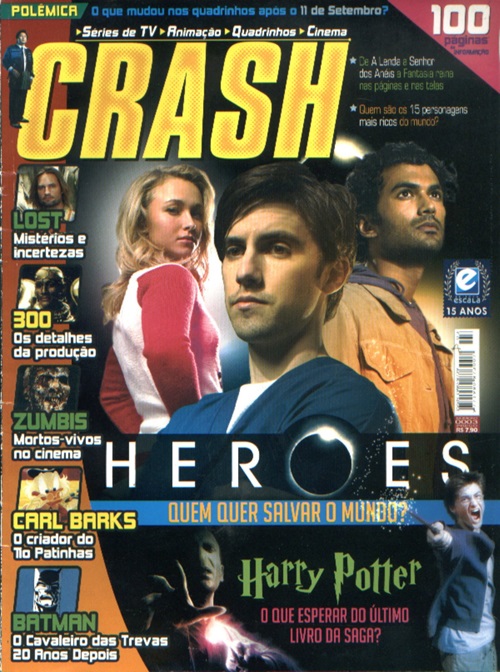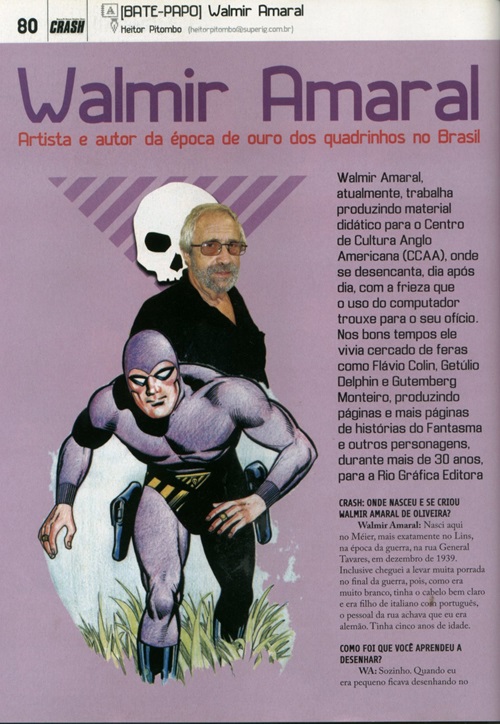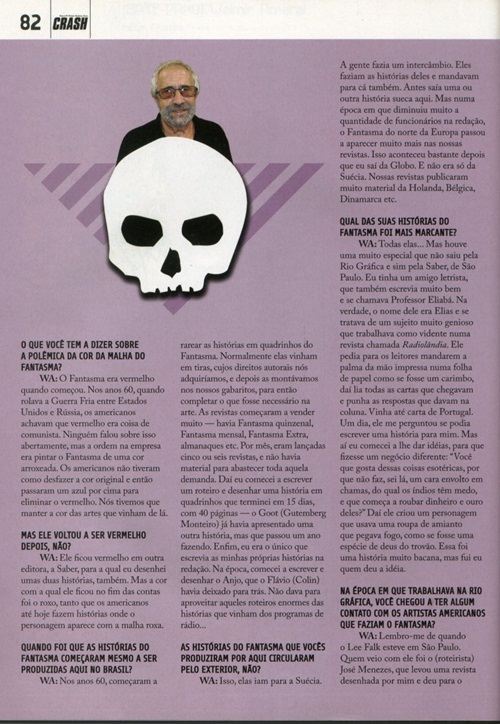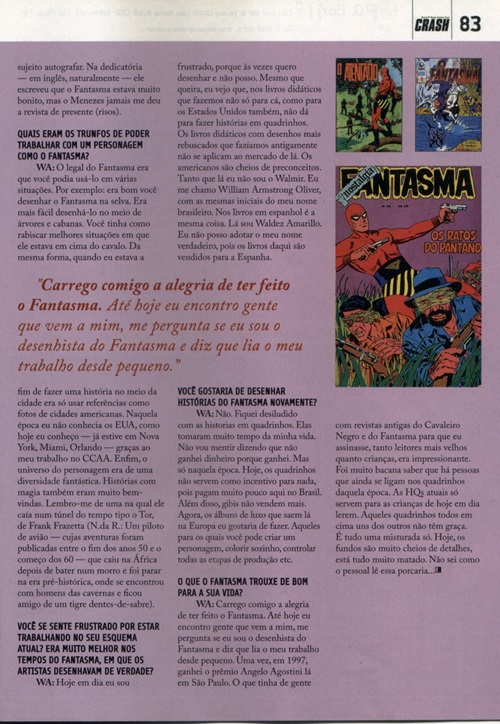Crash Magazine #3 was published by Ediga Escala in Brazil in March 2007. The magazine contains pop culture news and articles, featuring movies, TV shows, comic books and celebrities, published in color in Portuguese text. The front cover of this edition can be seen below.

In Crash Magazine #3, Brazilian artist/creator Walmir Amaral gave an in-depth interview with Heitor Pitombo, running for 4 pages from pages 80 to 83. He gives a very candid and honest interview, discussing his work with various publishing houses and comic book characters, including the Phantom (or Fantasma as he’s known in Brazil). The 4 pages containing the interview can be seen below.




Translated from Portuguese to English (using Google Translate), the interview is titled ‘Walmir Amaral – Artist And Author From The Golden Age Of Comics In Brazil‘ and can be read below.
Walmir Amaral, artist and author from the golden age of comics in Brazil Walmir Amaral currently works producing teaching material for the Anglo American Culture Center (CCAA), where he becomes disenchanted, day after day, with the coldness that the use of computers has brought to his job. In the good times he lived surrounded by beasts like Flávio Colin, Getúlio Delphin and Gutemberg Monteiro, producing pages and pages of stories about Fantasma and other characters, for more than 30 years, for Rio Gráfica Editora.
CRASH: WHERE WALMIR AMARAL DE OLIVEIRA WAS BORN AND RAISED?
Walmir Amaral: I was born here in Méier, more precisely in Lins, at the time of the war, on Rua General Tavares, in December 1939. I even got beaten up a lot at the end of the war, because, as I as very white, my hair was fine. Of course, I was the son of Italian and Portuguese parents, people on the street thought I was German. He was five years old.
HOW DID YOU LEARN TO DRAW?
Walmir Amaral: Alone. When I was little I used to draw on the floor; people passed by, they looked and I kept telling them the story I was drafting. It was still that childish trait, but you could see that I had a knack for the business.
DID THIS LIKE FOR DRAWING COME FROM COMICS?
Walmir Amaral: I’ve always liked comics. My mother was a regular with comic books. On Wednesdays and Sundays, those who woke up early to buy bread also went to the newsstand to buy magazines and supplements. At the time, there was the thin Gibi and, on Sunday, Globo Juvenil came out. But normally, on those days, I was always the first to wake up. And he was the first to read it, naturally. My brothers didn’t care much about comics, but I loved them. I paid attention to each drawing and to this day I know everything by heart; any type of revolver, pistol, American horse saddle, costume, etc.
IT WAS AT THIS TIME THAT YOU CAME IN CONTACT WITH THE GHOST FOR THE FIRST TIME, OF COURSE.
Walmir Amaral: Of course. The Phantom appeared on Globo Juvenil since the beginning of the 40s, during the war, when there was a campaign by the heroes against the Germans and the Japanese. That’s when I started to like comics and drawing. I went to school, drew dirty stories in my notebook and gathered a bunch of kids around wanting to see them.
HOW WAS THE PASSAGE FROM AMATEUR TO PROFESSIONALISM?
Walmir Amaral: At 17 I went to serve in the Army, but before that I met a girl who was a secretary for a big guy at Rio Gráfica. In fact, she was my girlfriend and, because she was older than me, she taught me everything about sex… But she ended up encouraging me to go to her work to look for a job. The head of the drawing department was a guy called Aires, an Argentine. He said to me: “Sit there. Try to draw a picture that will show me what you know do”. So I designed a business any and he said: “You’re hired”. The guy immediately said that I would start by “completing” drawings and explained to me what “completion” was – taking the American stories, removing their subtitles, using the template from the Rio Gráfica magazine, in this case Fantasma, Cavaleiro Negro, etc. After the Portuguese text was applied, it was necessary to complete the parts of the drawings that were cut. As an assistant, I did this for about three months. Gutemberg Monteiro worked alongside me (see interview issue no. 01), Flávio Colin, Benício, Getúlio Delphin and Milton Sardella, who were already doing covers and drawings. I looked at their work and thought I could draw too. I did not say anything. One day I wrote a ten-page Black Knight story by myself.
HOW DID YOU START DRAWING THE GHOST?
Walmir Amaral: Doing covers, for sure. “Sit there. Try to draw a picture that shows me what you can do”. So I drew some business and he said: “It’s signed”.
HOW MANY COVERS HAVE YOU MADE?
Walmir Amaral: About a hundred.
DO YOU HAVE ANY FAVORITE?
Walmir Amaral: I have two. The matte cover of an almanac that I don’t care about I remember the year and one of the last ones, that of the Phantom’s wedding, in which he is on the horse with Diana, and which came out in a hardcover album. Shortly afterwards, in the mid-80s, I stopped making covers and set up the Fantasma Team, which resumed producing Brazilian stories about the character, together with Wanderley (Mayhé) and Adauto Silva. Then, due to the large number of titles, I also ended up calling Julio Shimamoto and Antonino Homobono.
WHAT DO YOU HAVE TO SAY ABOUT THE CONTROVERSY OF THE COLOR OF THE GHOST’S MESH?
Walmir Amaral: The Phantom was red when it started. In the 1960s, when the Cold War was going on between the United States and Russia, Americans thought red was a communist thing. No one talked about it openly, but the order at the company was to paint the Phantom a purplish color. The Americans had no way of undoing the original color and so they applied blue over it to eliminate the red. We had to maintain the color of the arts that came from there.
BUT IT BECAME RED BACK AFTER, NO?
Walmir Amaral: It went red at another publisher, Saber, for which I drew a couple of stories, too. But the color he ended up with was purple, so much so that Americans to this day make stories where the character appears with a purple jersey.
WHEN DID THE GHOST STORIES REALLY BEGIN TO BE PRODUCED HERE IN BRAZIL?
Walmir Amaral: In the 60s, they began to rarer stories in Fantasma. Normally in strips, whose copyrights we acquired, and then we assembled them in our templates, to then complete whatever was necessary in the art. The magazines began to sell a lot, there were Fortnightly Fantasma, Monthly Fantasma, Extra Fantasma, almanacs, etc. There were five or six magazines a month, and there was no material to meet all that demand. Then I started to write a script and draw a comic book that I finished in 15 days, with 40 pages (Monteiro) had already Goot (Gutemberg presented another story, but what was he doing. Anyway, I was writing mine for a year own stories in the newsroom. At the time, I started writing and drawing the Angel, who had left him behind. Flávio (Colin) took advantage of those huge scripts of stories that came from the radio programs… comics were released only by those who came up with the idea.
THE GHOST STORIES THAT YOU PRODUCED HERE WERE CIRCULATED ABROAD, NO?
Walmir Amaral: Yes, they were going to Sweden. We did an exchange. They made their stories and sent them here too. There used to be one or two Swedish stories here. But in a time when the number of employees in the newsroom was greatly reduced, the Northern European Ghost started to appear much more in our magazines. This happened a lot after I left Globo. And it wasn’t just from Sweden. Our magazines published a lot of material from Holland, Belgium, Denmark, etc.
WHICH OF YOUR GHOST STORIES WAS THE MOST POWERFUL?
Walmir Amaral: All of them… But there were a very special one that was not published by Rio Gráfica but by Saber, in São Paulo. I had a lyricist friend, who also wrote very well and was called Professor Eliabá. In fact, his name was Elias and he was a very genius guy who worked as a psychic in a magazine called Radiolandia. He asked readers to send the palm of their hand printed on a sheet of paper as if it were a stamp, then he read all the letters that arrived and put the answers they gave in the column. There was even a letter from Portugal. One day, he asked me if he could write a story for me. But then I started giving him ideas, so he could do something different: “If you like these esoteric things, why don’t you make, I don’t know, a guy engulfed in flames, who the Indians are afraid of, and who starts stealing their money and gold?” Then he created a character who wore an asbestos suit that caught fire, as if he were some kind of thunder god. That was a really cool story, but that was me.
WHEN YOU WORKED AT RIO GRÁFICA, DID YOU HAVE ANY CONTACT WITH THE AMERICAN ARTISTS WHO MADE FANTASMA?
Walmir Amaral: I remember when Lee Falk was in São Paulo. The one who came with him was (screenwriter) José Menezes, who took a magazine designed by me and gave it to the subject to autograph. In the dedication in English, naturally he wrote that Fantasma was very beautiful, but Menezes never gave me the magazine as a gift (laughs).
WHAT WERE THE ADVANTAGES OF BEING ABLE TO WORK WITH A CHARACTER LIKE GHOST?
Walmir Amaral: The cool thing about the Phantom was that you could use it in a variety of situations. For example: it would be good if you drew the Phantom in the jungle. It was easier to draw him among trees and huts. You could write better situations in which he was on the horse. Likewise, when I was frustrated, because sometimes I want to draw and I can’t. Even if I wanted to, I see that, in the textbooks we make not only here, but also in the United States, it is not possible to make comic books. The textbooks with more elaborate designs that we used to make are not applicable to the market there. Americans are full of prejudices. So much so that I’m not Walmir there. My name is William Armstrong Oliver, with the same initials as my Brazilian name. In books in Spanish it’s the same thing. There I am Waldez Amarillo. I can’t adopt my real name, because the books here are sold to Spain. “I carry with me the joy of having created Fantasma. To this day I meet people who come up to me, ask me if I am the designer of Fantasma and say that they have read my work since I was little”. In order to make a story in the middle of the city, I just used references such as photos of American cities. At that time I didn’t know the USA, as I do now – I’ve been to New York, Miami, Orlando thanks to my work at CCAA. Anyway, the character’s universe was fantastically diverse. Stories with magic were also very welcome. I remember one in which he fell into a time tunnel like Tor, by Frank Frazetta (N.da R.: A pilot plane whose adventures were published between the end of the 50s and the beginning of the 60s, which crashed in Africa after hitting a hill and ended up in the prehistoric era, where he met cavemen and became friends with a toothy tiger. de-saber).
DO YOU FEEL FRUSTRATED BEING WORKING IN YOUR CURRENT SCHEME? WAS IT MUCH BETTER IN THE TIMES OF GHOST, WHEN ARTISTS REALLY DRAWED?
Walmir Amaral: Nowadays I am.
WOULD YOU LIKE TO DRAW GHOST STORIES AGAIN?
Walmir Amaral: No. I became disillusioned with comic books. They took up a lot of time in my life. I’m not going to lie and say I didn’t make money because I did. But only at that time. Today, comics don’t serve as an incentive for anything, as they pay very little here in Brazil. Plus, comic books don’t sell anymore. Now, I would like to do the luxury albums that come out in Europe. Those you can create a character for, color it yourself, control all stages of production, etc.
WHAT GOOD DID THE GHOST BRING TO YOUR LIFE?
Walmir Amaral: I carry with me the joy of having made Fantasma. To this day I meet people who come up to me, ask me if I am the designer of Fantasma and say that they have read my work since I was little. Once, in 1997, I won the Angelo Agostini award there in São Paulo. What did we have with old Black Knight and Ghost magazines for me to subscribe to, both older readers and children, it was impressive. It was really cool to know that there are people who still connect with comics from that time. Current comics are only suitable for today’s children to read. Those comics all on top of each other are not funny. It’s all just a mix. Today, the backgrounds are very full of details, everything is very dead. I don’t know how people read this crap…